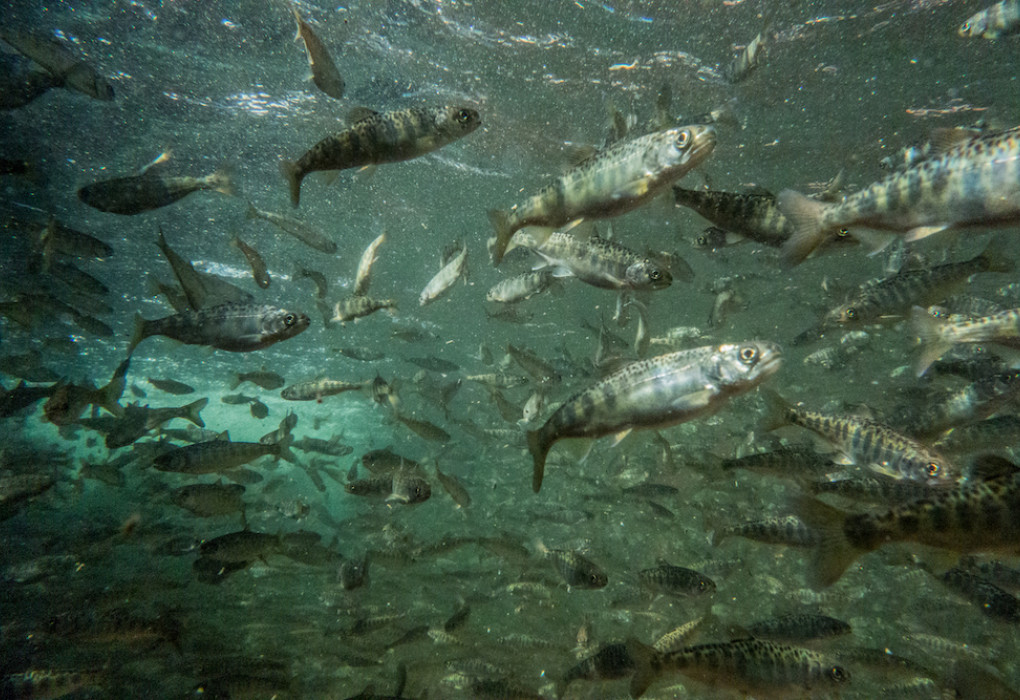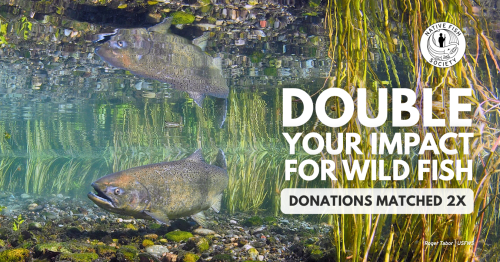River Stewards to NOAA: Protect wild fish, not artificial production.
Thank you for the opportunity to comment on the proposal to include hatchery programs as part of Pacific salmon and steelhead species listed under the Endangered Species Act (ESA). As a diverse community of local River Stewards advocates based in watersheds across the Northwest, we are writing to express our strong opposition to the proposal to list 23 hatchery programs, the majority of which serve no conservation purpose, as protected species under the ESA. Additionally, we respectfully request that the National Marine Fisheries Service (NMFS) conduct a thorough environmental impact statement (EIS) for this proposal and develop a formal and public process to reconsider the 2005 Hatchery Listing Policy.
As River Stewards working within our local communities to build support for science-based solutions to wild salmon and steelhead recovery, this proposed action is especially concerning and problematic. For more than a decade the best-available science states genetic and ecological impacts from hatchery salmon and steelhead populations as a significant stressor to threatened wild populations. This message regarding the science is not easily received and it takes time to convey this information and build trust around recovery actions that focus on addressing the root causes of wild fish decline.
The proposal to add 23 hatchery programs to the listed salmon and steelhead Evolutionary Significant Units (ESUs) and Distinct Population Segments (DPSs) raises serious concerns for the recovery of ESA-listed wild salmon and steelhead stocks and requires a substantial scientific review. There are significant inadequacies and scientific shortcomings in NMFS’ Federal Register (FR) Notice for this proposal and in the supporting documentation. Moreover, the eleven-year-old Listing Policy is out of date and is inconsistent with the best available scientific data and knowledge, which have evolved and become far more sophisticated over the last decade.
There exist numerous scientific gaps and unfounded logical leaps in the FR Notice and the supporting documentation. Making matters worse, these documents fail to provide objective criteria for determining which hatchery populations, if any, may qualify for inclusion in listed ESUs and DPSs. As a result any description of the relationship between specific hatchery programs and listed wild populations is likely to be subjective, arbitrary, and capricious.
Particularly concerning is that NMFS cites only two documents that provide genetic data that may be relevant to the proposal – a 2003 Salmon Steelhead Hatchery Assessment Group (SSHAG) assessment of hatchery broodstocks within the ESUs at issue in this proposal and a 2004 Salmonid Hatchery Inventory and Effects Evaluation Report (SHIEER) assessing the effect of hatchery programs on the status of the same ESUs. Both of these documents are outdated with respect to the harmful effects of hatchery programs on the status and recovery prospects of the ESUs at issue. Furthermore, these documents fail to provide any specific data, genetic or otherwise, that permit a serious scientific evaluation of the claims in the FR Notice that the 23 populations “exhibit a level of genetic divergence relative to the local natural population(s) that is not more that what occurs within the ESU/DPS.”
The FR Notice also fails to explain how NMFS’s “recently completed 5-year reviews under ESA” actually informs the proposed actions. No quantitative data or related analyses are provided to justify the assertions that specific hatchery programs and populations warrant inclusion in the 23 listed ESUs and DPSs proposed. Additionally, NMFS fails to provide or even discuss any objective, measurable biologically relevant criteria and methods for determining whether or not any hatchery populations are “no more moderately diverged” from the natural spawning, wild populations in a listed ESU or DPS.
It is also distressing that these documents focus purely (albeit inadequately) on genetics and still fail to address features of life history, ecology and demography of populations that are equally important. These issues were a prevailing concern of the Hatchery Science Review Group (HSRG) in 2004 as well as being a common concern among fisheries scientists and geneticists. Therefore, it is surprising and noteworthy that nowhere does the proposal address the principle metrics pHOS (percent of hatchery-origin spawners on spawning grounds with wild fish) and PNI (percent natural influence). Nor does the proposal provide or discuss any of the data that allegedly justifies the proposed additions to the ESUs in terms of past and current levels of pHOS and PNI. This shortcoming is egregious and concerning as the direct and indirect effects of hatchery genetic introgression will diminish the fitness of ESA-listed wild populations and further undermine their chance of recovery.
This proposal to add more hatchery programs to ESA-listed ESUs and DPSs is a dangerous step. It is a step that raises the prospect of perpetually adding hatchery programs that have already genetically introgressed listed wild populations sufficiently to establish some undefined genetic “similarity” to wild populations when measured at a small number of (as-yet unspecified) neutral genetic markers – essentially rewarding poor hatchery management practices that pose threats to the fitness and recovery potential of ESA-listed wild populations. Furthermore, the decision to propose listing several hatchery programs that are (or appear to be) segregated programs is shocking considering that these segregated programs are well-established as harmful to the survival and recovery of ESA-listed wild salmon and steelhead populations.
In light of these considerations, we strongly recommend and request that:
- NMFS postpone the proposed action and produce a full environmental impact statement of the proposed action that includes proper alternatives analysis.
- NMFS convene an advisory panel composed of a balance of scientists from NMFS’s Northwest and Southwest Fisheries Science Centers and independent university scientists to evaluate the outdated 2005 Hatchery Listing Policy and recommend revisions to the scientific basis of the Listing Policy.
Thank you for the opportunity to voice our concerns about this critically important issue. We hope that NMFS values the comments raised in this letter and heeds our strong recommendation to conduct a comprehensive EIS for this proposal as well as evaluate/revise the 2005 Hatchery Listing Policy.
Respectfully,
Mark Sherwood, Conrad Gowell, Jake Crawford, Tom Derry, Jason Small, Paul Engelmeyer, Peter Donahower, Bryan Sohl, Dan Peirce, Scott Baumer, William Atlas, Brice Crayne, Bill Bakke, Rachael Andras, Ed Call, Chris Daughters, Duncan Berry, John Appleton, Mark Homeyer, Charles Gehr, Dave Gee, Todd Hirano, Doug DeRoy, Dave Gee, Jeff Hickman, Scotty Evens, Spencer Miles, Alan L’Hommedieu, Bob Margulis, Bart Mills, Jena Lemke, Dave Lacey, Steve Lent, Michael Mathis, Matt McQueen, Peter Tronquet, Ed Megill, Matt Lund, Ken Johnson, Chris Johnson, James Smith, Mark Schmidt, Joyce Sherman, Brent Ross, Jake Robinson, Eric Shoemaker,. Walt Weber, Keith Stonebraker, Scott Willison, Kellen Igou, Ty Holloway, Chris Menaul, Mia Sheppard, Gena Goodman-Campbell, Bryce Levin, Adam Bronstein, Sunny Bourdon, Jonathan Knapp, Rowan Baker, Derek Day, Dane Downing, Samantha Kannary, Kent MacIntosh, Dave Petersen, Dustin Revel, Mark Stangeland, Sal Steinberg, Eric Reygers, Ryan Allred, Bradley Bobbit, Dave Carpenter, John McConnaughey, Dave McCoy, Chrystal McMahon, Stan Petrowski, Russ Ricketts, Christie Adelsberger, and Paul Huston
On December 20th, 2016 78 River Stewards from throughout the Northwest submitted the following letter to NOAA-National Marine Fisheries Service regarding the protections of hatchery fish through the Endangered Species Act.
Watersheds
- 15 Mile Creek
- Bear Creek
- Black Butte River
- Chetco River
- Clackamas River
- Clearwater River
- Crooked River
- East Fork Lewis River
- Eel River
- Garcia River
- Grande Ronde River
- Green/Duamish River
- Gualala River
- Hood River
- Hunter Creek
- Illinois River
- John Day River
- Johnson Creek
- Klamath River
- Klickitat River
- Lost River
- Lower Columbia Tributaries
- Lower Deschutes
- McKenzie River
- Metolius River
- Molalla River
- Navarro River
- Necanicum River
- Nehalem River
- Nestucca River
- Nisqually River
- Nooksack River
- North Puget Sound Tributaries
- North Santiam River
- North Umpqua River
- Rogue River
- Salmon River
- Salmonberry River
- Sandy River
- Siletz River
- Skagit River
- Skykomish River
- Smith River
- Snake River - Lower Hell's Canyon
- Snohomish River
- Snoqualamie River
- South Puget Sound Tributaries
- South Umpqua River
- Sprague River
- Stilliguamish River
- Sycan River
- Toutle River
- Trask River
- Umpqua River
- Upper Deschutes River
- Van Duzen River
- Washougal River
- Wenatchee River
- Williamson River
- Wilson River
- Winchuck River
- Yakima River
- Yaquina River
- Zigzag River
River Stewards
- Adam Bronstein
- Alan L'Hommedieu
- Barrett Ames
- Bryan Sohl
- Chris Daughters
- Christie Nichols
- Crystal McMahon
- Dane Downing
- Daniel Peirce
- Dave Lacey
- Dave McCoy
- James Smith
- Joyce Sherman
- Marshal Moser
- Matt Lund
- Peter Tronquet
- Rachel Andras
- Ryan Allred
- Sal Steinberg
- Stanley Petrowski
- Sunny Bourdon
- Tom Derry



